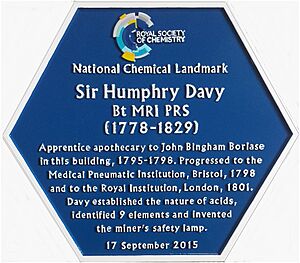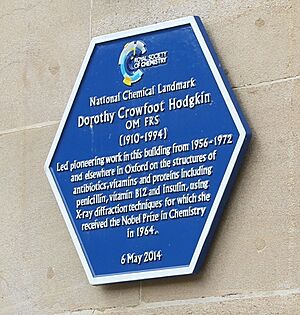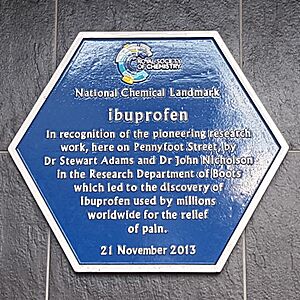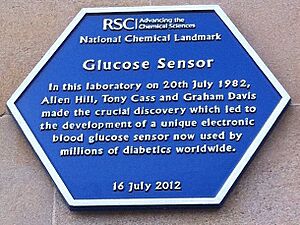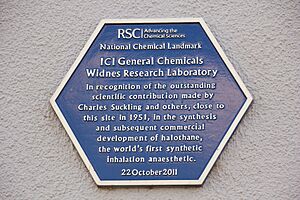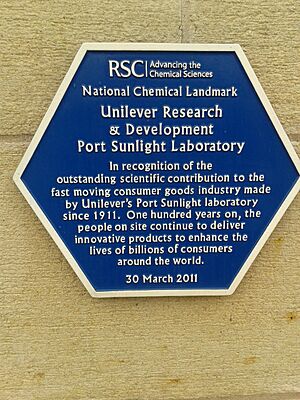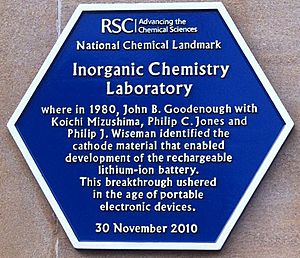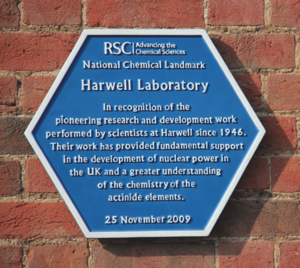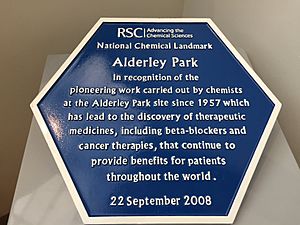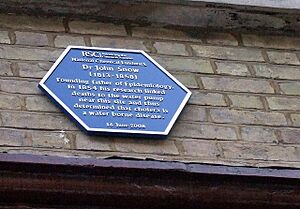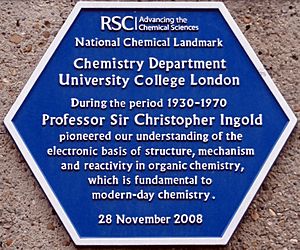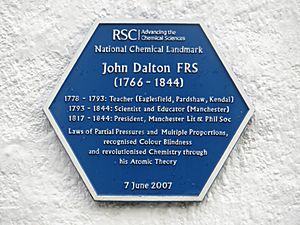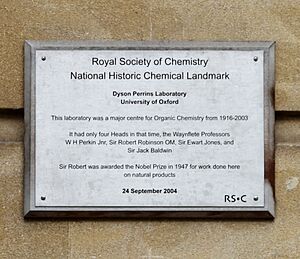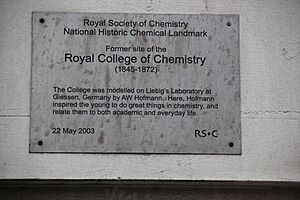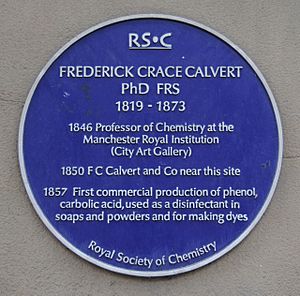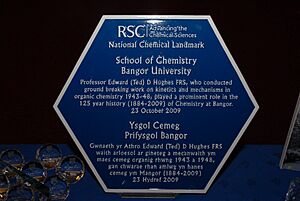List of blue plaques erected by the Royal Society of Chemistry facts for kids
The Royal Society of Chemistry puts up special signs called blue plaques to celebrate important places where chemistry has made a big difference. These plaques help everyone see how chemistry is part of our daily lives. They show us where amazing discoveries happened that changed health, wealth, or how we live.
Contents
Celebrating Chemical Discoveries
The Royal Society of Chemistry started its Chemical Landmark Scheme (CLS) in 2001. This program honors places where chemistry has had a huge impact. The plaques are easy to see and teach people about chemistry's importance.
At first, the CLS plaques were rectangular with black letters on a steel background. Later, they changed to a hexagonal shape with white letters on a blue background. These plaques are a way to remember and share the history of chemistry.
Amazing Chemistry in England
Here are some of the places in England where chemistry has made a mark:
- Beecham Research Laboratories
* In 1957, scientists here found a chemical that helped create many new penicillin medicines. These medicines have saved millions of lives by fighting bacterial infections. * Location: The Shop at Strood Green, 1 Tynedale Road, Betchworth, Surrey * Year: 2016
* Sir John Cornforth was a Nobel Prize winner in Chemistry in 1975. He worked at the Shell Research Ltd Milstead Laboratory. His team discovered how enzymes work and how cholesterol builds up in the body. * Location: Kent Science Park, Broadoak Road, Sittingbourne, Kent * Year: 2016
* Sir Edward Frankland was a chemistry professor who went to school here from 1837 to 1839. He discovered many new chemical compounds and helped improve drinking water. * Location: Lancaster Royal Grammar School, East Road, Lancaster * Year: 2015
* Sir Humphry Davy was an apprentice here from 1795 to 1798. He figured out what acids are, found 9 new elements, and invented the miner's safety lamp. * Location: 1 Market Place, Penzance * Year: 2015
*
* Robert Angus Smith lived and worked in Manchester for 40 years. He was the first person to use the term 'acid rain' in 1859, after studying air quality. * Location: Oxford Road, Manchester * Year: 2015
*
* This plaque celebrates Daniel Eley, a brilliant physical chemist. His research, much of it done in Nottingham, connected chemistry, physics, and biology. He even discovered that DNA can conduct electricity! * Location: The School of Chemistry, University of Nottingham, University Park, Nottingham * Year: 2014
- Saltend Chemicals Park
* This park has been a center for chemical innovation for 100 years. It has developed new ways to make important chemicals like organic acids and alcohols. * Location: BP Chemicals Ltd, Saltend Chemicals Park, Hull * Year: 2014
- Johnson Matthey plc
* This site is where the world's first commercial car catalysts were made 40 years ago. These catalysts and filters have cleaned billions of tons of pollution from our air. * Location: Johnson Matthey, Orchard Road, Royston, Hertfordshire * Year: 2014
* Dorothy Hodgkin won the Nobel Prize in Chemistry in 1964. She used X-ray diffraction to figure out the structures of important molecules like penicillin, vitamin B12, and insulin. * Location: Department of Chemistry, University of Oxford, South Parks Road, Oxford * Year: 2014
*
* This plaque recognizes the work by The Boots Company PLC in the 1980s. They helped make ibuprofen available without a prescription, so millions more people could use it for pain relief. * Location: Building D6 at Boots Beeston Factory Site, Dunkirk Industrial Estate, 1 Thane Road, Nottingham * Year: 2013
- Ibuprofen Discovery
* This plaque celebrates the original research by Dr. Stewart Adams and Dr. John Nicholson at Boots. Their work led to the discovery of ibuprofen, a pain reliever used by millions worldwide. * Location: BioCity Nottingham, Pennyfoot Street, Nottingham * Year: 2013
*
- Surface-enhanced Raman spectroscopy (SERS)
* In 1973, scientists at the University of Southampton recorded the first SERS. This technique is now used globally for very sensitive chemical analysis. * Location: University of Southampton, Highfield, Southampton * Year: 2013
- Rev Ron Lancaster
* This plaque honors Rev. Ron Lancaster for his amazing contributions to fireworks. He spent over 50 years researching and developing fireworks and professional displays. * Location: Kimbolton School, Kimbolton, Cambridge * Year: 2013
* Lord George Porter won the Nobel Prize in 1967 for studying very fast chemical reactions. He was a visiting professor at Imperial College London. * Location: Wolfson Laboratories, Imperial College London, South Kensington Campus, London * Year: 2012
- Glucose Sensor
* In 1982, scientists Allen Hill, Tony Cass, and Graham Davis (Chemist) made a key discovery here. This led to the electronic blood glucose sensor, which millions of diabetics use today. * Location: Inorganic Chemistry Laboratory, South Parks Road, Oxford * Year: 2012
*
- Thomas Graham House
* This plaque celebrates 170 years of scientific publishing by the Royal Society of Chemistry. Their publications have greatly helped chemistry advance. * Location: Thomas Graham House, Science Park, Milton Road, Cambridge * Year: 2011
*
- ICI General Chemicals, Widnes Research Laboratory
* This plaque recognizes the work of Charles Suckling and others in 1951. They created halothane, the world's first synthetic inhaled anesthetic, which changed medicine. * Location: Catalyst Science Discovery Centre, Mersey Road, Widnes, Cheshire * Year: 2011
*
* This plaque marks 100 years since Ernest Rutherford discovered the atomic nucleus at the University of Manchester. He was a Nobel Prize winner and a pioneer in nuclear physics. * Location: Rutherford Building, Coupland Street, University of Manchester, Manchester * Year: 2011
*
- Unilever Research & Development Port Sunlight Laboratory
* This plaque celebrates 100 years of amazing scientific work at Unilever Port Sunlight. They have created innovative products that improve the lives of billions of people worldwide. * Location: Merseyside * Year: 2011
*
- Rechargeable Lithium-Ion Battery
* In 1980, John B. Goodenough and his team identified a key material here. This breakthrough led to the development of the rechargeable lithium-ion battery, powering our phones and laptops today. * Location: Inorganic Chemistry Laboratory, South Parks Road, Oxford * Year: 2010
*
- Pfizer Sandwich
* This plaque recognizes Pfizer scientists for their important work since 1957. They have discovered and developed many new medicines for people and animals, improving health and quality of life. * Location: Sandwich, Kent * Year: 2010
- Sanofi-Aventis, Dagenham Site
* This plaque celebrates the pioneering research and manufacturing at the May & Baker (sanofi-aventis) Dagenham site since 1934. Their products continue to help patients around the world. * Location: Dagenham, Essex * Year: 2010
- Medical Research Council Human Nutrition Research
* This plaque honors Dr. Elsie Widdowson (1906–2000) for her groundbreaking work in nutrition science. Her research laid the foundation for improving public health. * Location: Human Nutrition Research, 120 Fulbourn Road, Cambridge * Year: 2009
- Harwell Laboratory
* This plaque recognizes the pioneering research at Harwell since 1946. Their work supported the development of nuclear power in the UK and helped us understand actinide elements. * Location: Harwell Campus Management HQ Building, Thomson Avenue, Didcot * Year: 2009
*
* Sir Joseph Swan was a chemist, physicist, and inventor of the light bulb. He first showed his light bulb here in 1879. Nearby Mosley Street was the first street in the world lit by electric bulbs. * Location: Literary and Philosophical Society of Newcastle, 23 Westgate Road, Newcastle upon Tyne * Year: 2009
- Chemistry Department, University College London (Sir Christopher Ingold)
* From 1930 to 1970, Professor Sir Christopher Ingold helped us understand how electrons affect chemical structures and reactions. This is a basic part of modern chemistry. * Location: University College London, 20 Gordon Street, London * Year: 2008
- Alderley Park
* This plaque celebrates the chemists at Alderley Park who, since 1957, discovered important medicines. These include beta-blockers and cancer treatments that help patients worldwide. * Location: AstraZeneca, Alderley Park, Macclesfield * Year: 2008
*
* John Snow was a key figure in understanding diseases. In 1854, his research linked deaths to a water pump near this site, showing that cholera is spread through water. * Location: Broadwick (formerly Broad) Street, Soho, London * Year: 2008
*
- Chemistry Department, University College London (Sir Christopher Ingold)
* This plaque also honors Professor Sir Christopher Ingold for his work between 1930 and 1970. He helped us understand the electronic basis of chemical structure and reactions. * Location: Gordon St, Bloomsbury, Euston, London * Year: 2008
*
- Jealott's Hill International Research Centre
* Since 1928, scientists here have done pioneering work in agriculture. Their research has led to global developments that help feed people and improve their lives. * Location: Syngenta, Jealott's Hill International Research Centre, Berkshire * Year: 2007
- Clarendon Laboratory (Henry Moseley)
* H.G.J. Moseley did important studies here from 1887 to 1915. His work on X-rays helped establish the idea of atomic number and revealed the structure of the atom. * Location: Clarendon Laboratory, Sherrington Road, Oxford * Year: 2007
*
* John Dalton was a teacher and scientist who revolutionized chemistry with his atomic theory. He also recognized color blindness. * Location: John Dalton Cottage, Eaglesfied * Year: 2007
*
* Sir Derek Barton was a Nobel Laureate in 1969 for his new ideas about how organic molecules are shaped. He was a student and professor at Imperial College London. * Location: Imperial College London, South Kensington Campus, London * Year: 2007
* Sir Geoffrey Wilkinson won the Nobel Prize in 1973 for his pioneering studies on organometallic compounds. He was also a student and professor at Imperial College London. * Location: Imperial College London, South Kensington Campus, London * Year: 2007
* In 1856, Sir William H. Perkin discovered mauveine, the world's first synthetic dye. He and his brother produced it here, starting the organic chemicals industry. * Location: Oldfield Lane N, Greendford, London * Year: 2006
* This site has been a key place for developing and producing dyes in the UK since 1786. It is recognized as a Chemical Landmark. * Location: Hexagon Tower, Crumpsall Vall, Blackley, Manchester * Year: 2006
- Natural Products Research
* For over 50 years, research at the University of Cambridge has helped us understand the structures of molecules that control life processes. Lord Alexander Todd invented the chemical synthesis of nucleotides, which led to understanding DNA's structure. * Location: Department of Chemistry, University of Cambridge, Lensfield Road, Cambridge * Year: 2005
* Research at the University of Hull for over 50 years has led to the design of liquid crystals for display devices. Professor George Gray invented the cyanobiphenyl materials, which were crucial for the first successful liquid crystal displays. * Location: Hull * Year: 2005
- William Ramsay, Nobel Laureate 1904
* Between 1894 and 1910, William Ramsay discovered and described the noble gases near this site. This completed the structure of the Periodic Table of Elements. * Location: University College London, Gower Street, London * Year: 2004
- Winnington Laboratory (Polyethylene)
* This plaque celebrates the discovery of polyethylene (polythene) by R. O. Gibson and E. W. Fawcett in 1933. They worked in the former ICI research laboratory near this site. * Location: Winnington Hall, Winnington Lane, Northwich, Winnington * Year: 2004
- Dyson Perrins Laboratory
* This laboratory was a major center for Organic Chemistry from 1916 to 2003. Robert Robinson won the Nobel Prize in 1947 for his work here on natural products. * Location: Oxford Radiocarbon Accelerator Unit, Dyson Perrins Building, South Parks Road, Oxford * Year: 2004
*
- Silicone Polymers
* This plaque honors Professor Frederic S. Kipping for his pioneering work on silicone polymers. His research formed the basis for the worldwide synthetic rubber and silicone lubricant industries. * Location: School of Chemistry, University of Nottingham, Nottingham * Year: 2004
* Near this site, between 1912 and 1914, Sir William H. Bragg and his son Sir W. Lawrence Bragg did research that won them the Nobel Prize in Physics in 1915. Their work on X-ray diffraction helped understand crystal structures. * Location: School of Chemistry, University of Leeds, Leeds * Year: 2003
- Former site of the Royal College of Chemistry
* This college, open from 1845 to 1872, was modeled after a famous German laboratory. Here, AW Hofmann inspired young chemists and connected chemistry to both academic and everyday life. * Location: 299 Oxford Street, London * Year: 2003
*
- King's College London (DNA Structure)
* Near this site, Rosalind Franklin, Maurice Wilkins, and their team did experiments that led to the discovery of the structure of DNA. This work completely changed our understanding of life's chemistry. * Location: The Strand, King's College London, London * Year: 2003
* In 1984, the principles behind DNA fingerprinting were discovered in this building by Professor Sir Alec Jeffreys and his research group. This discovery is very important in forensics and genetics. * Location: Department of Genetics, University of Leicester, Leicester * Year: 2002
* For over 300 years, explosives and propellants were developed and produced here. Work done at this site influenced technologies like the Bouncing Bomb, Kevlar, and Ejector Seat technology. * Location: Waltham Abbey * Year: 2002
* Between 1940 and 1943, near this site, Dr. Martin and Dr. Synge developed chromatography. This technique separates chemicals and became a basis for much chemical analysis. They won the Nobel Prize in 1952 for this work. * Location: Leeds * Year: 2001
- Johnson Matthey Technology Centre
* Since 1970, pioneering work has been done here on Platinum Group Metals. This led to car exhaust catalysts, which improve air quality, and platinum anti-cancer drugs, important in cancer therapy. * Location: Berkshire * Year: 2001
* Frederick Crace Calvert was a professor of chemistry and started his company near this site. In 1857, he produced phenol (carbolic acid) commercially for the first time. It was used as a disinfectant in soaps and for making dyes. * Location: Princess Street, Manchester * Year: Unknown
*
Chemistry in Scotland
Scotland also has a rich history of chemical discoveries:
* Born in Glasgow, Thomas Graham was a chemistry professor from 1830 to 1837. He is famous for Graham's Law of Diffusion and his work on dialysis. He also founded the Chemical Society of London. * Location: Department of Pure & Applied Chemistry, University of Strathclyde, Thomas Graham Building, 295 Cathedral Street, Glasgow * Year: 2014
* James Young made an outstanding contribution by processing "cannel coal" to create the world's first commercial paraffin oil around 1850. This started a major shale oil industry. * Location: Bennie Museum, 9–11 Mansefield Street, Bathgate * Year: 2012
- Professor Joseph Black (Glasgow)
* Joseph Black was a student and professor at the University of Glasgow. He discovered latent heat at the Old College. * Location: University of Glasgow, Joseph Black Building, University Place, Glasgow * Year: 2009
- Professor Joseph Black (Edinburgh)
* Joseph Black was a graduate and professor at the University of Edinburgh. He discovered the properties of "fixed air" (carbon dioxide) and promoted the Scottish chemical industry. * Location: University of Edinburgh, Joseph Black Building, David Brewster Road, Edinburgh * Year: 2009
Chemistry in Northern Ireland
Northern Ireland has also contributed to chemistry:
* In 1869, near this site, Thomas Andrews discovered the 'critical temperature' for liquefying carbon dioxide. This was a basic idea for cryogenics (very low temperature science) and low-temperature chemistry and physics. * Location: Queen's University Belfast, University Road, Belfast * Year: 2013
Chemistry in Wales
Wales has its own chemical landmarks:
- Professor Edward Hughes
* Professor Edward (Ted) D. Hughes did groundbreaking work on how organic chemical reactions happen from 1943 to 1948. He played a big role in the history of chemistry at Bangor University. * Location: School of Chemistry, Bangor University, Bangor, Gwynedd * Year: 2009
*
International Chemistry Landmarks
The Royal Society of Chemistry also recognizes important chemical sites outside the UK:
* This plaque recognizes August Kekulé for his pioneering work at Ghent University (1858–1867). He focused on the structure of organic aromatic chemicals. * Location: Ghent University, Aula Ugent, Voldersstraat 9, Gent, Belgium * Year: 2011
* This plaque honors the Institut de France for recognizing British Chemist Sir Humphry Davy in 1808. It also celebrates how they encouraged the international sharing of scientific knowledge. * Location: Paris, France * Year: 2008
Other Important Chemistry Plaques
Here are some other significant plaques that highlight chemical achievements:
* Sir Edward Frankland was a Professor of Chemistry from 1851 to 1857. He worked on organometallic compounds and water analysis. Sir Henry Enfield Roscoe was a Professor from 1857 to 1886, studying vanadium and spectroscopy. * Location: former County Court, Quay Street, Manchester * Year: Unknown
*
- The Development of penicillin
* In 1928, Alexander Fleming discovered penicillin at St. Mary's Hospital. This led to antibiotics that greatly reduced deaths from infections. Howard W. Florey, Ernst B. Chain, and their team at the University of Oxford developed penicillin into a medical treatment in 1941. * Location: St Mary's Hospital, Praed Street, London * Year: 1999
* On this site, in the former New Meeting House, Joseph Priestley was a scholar, scientist, and theologian. He discovered oxygen and served his congregation here from 1780 to 1791. * Location: St Michael's Church, New Meeting Street, Birmingham * Year: 1980
*
* John Dalton taught natural philosophy and mathematics at the Academy on this site from 1793 to 1800. He first presented his famous Atomic Theory in 1803 to the Manchester Literary and Philosophical Society. * Location: Peace Garden, Manchester * Year: 2003
*


